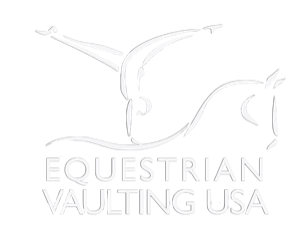Vaulting Safety
Vaulting Safety

Photo courtesy Tim Sutherland
The Three Points of Vaulting Safety
Vaulting is considered a very safe sport – the safest of any equestrian sport. The Three Points of Vaulting Safety is the basis for the AVA’s superb safety record and differentiates vaulting from other equestrian sports. These three points are:
1. Controlled environment
2. Safety training
3. Nature of the sport/horse
1. Controlled Environment
In vaulting the horse is not controlled by the vaulter but by an experienced lunger. Safety is not based on the vaulter’s judgment. (Many studies cite young equestrians in other disciplines being “overmounted” as contributing to rider loss of control and injury–not the case in vaulting.) Control of the horse is ground-based on a 20-meter circle in an enclosed arena, with special footing for the comfort and safety of both humans and equines. The fully equipped vaulting horse may look peculiar to those used to a typical horse with saddle and bridle. Instead of a saddle, a specially designed girth called a vaulting surcingle is used. It has two large leather handles and two leather loops, called Cossack straps, for the feet. Beneath the surcingle is a foam pad for the comfort of the horse. Finally, vaulters wear clothing that will not snag or cause them to become unbalanced as they move. For more information about why vaulters do not use helmets, click here.
2. Safety Training
The United States Pony Club Vaulting Handbook states, “Vaulting has a very much lower incidence of injury than riding (even “flat riding”). There are two major reasons: the vaulter does not control the horse, so he cannot lose control; development of safety techniques is an integral part of every vaulting lesson from the very beginning.” Attention to safety and safety practices are part of every vaulting practice. Vaulters practice their vault-off and compulsory and freestyle moves on the vaulting barrel prior to working on horseback. The vault-off, in which the vaulter learns to dismount quickly and with control in the event of a loss of balance or emergency, greatly enhances the vaulter’s safety.
3. Nature of the Sport/Horse
Vaulting is performed in a highly controlled environment—a fully enclosed arena with the horse on the end of a lunge line in a 20-meter circle with soft footing. This decreases the likelihood of environmental factors that cause riders to lose control of and possibly fall from their horses.
Vaulting’s focus is on working harmoniously with the horse. Requirements for the vaulting horse include being at least 6 years old, a mare or gelding, and having an even gait. Most importantly, vaulting horses have a quiet, steady behavior and accept a variety of movements from the vaulters without changing gait or attitude. These requirements decrease the risk of the horse spooking or running away, all of which can cause rider falls and injury.

Photo courtesy Jerry Yang
